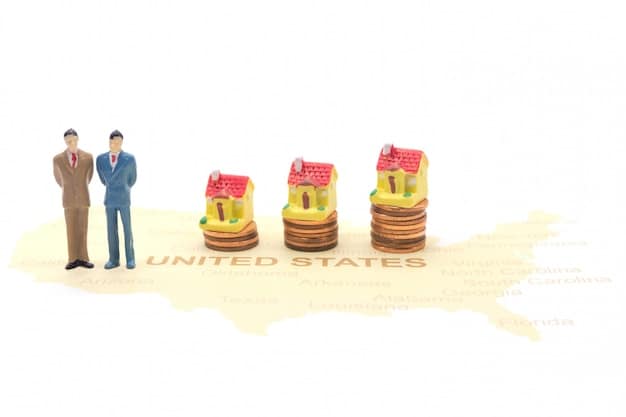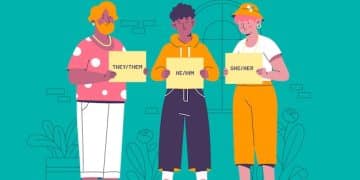Federal Minimum Wage: Impact on US Low-Wage Workers

A federal minimum wage increase impacts low-wage workers across the nation by potentially raising their earnings, reducing poverty, and stimulating the economy, but it may also lead to job losses and increased prices.
The debate surrounding the federal minimum wage and its potential increase is a long-standing one, with significant implications for low-wage workers across the nation. A federal minimum wage increase: how this impacts low-wage workers across the nation is a complex issue, touching on economic growth, poverty reduction, and the labor market.
Understanding the Federal Minimum Wage
The federal minimum wage is the lowest hourly wage that employers can legally pay to their employees. Established under the Fair Labor Standards Act of 1938, it has been a cornerstone of labor law in the United States. Over the years, the minimum wage has been periodically increased to reflect changes in the cost of living and economic conditions.
Currently, the federal minimum wage is $7.25 per hour, a rate that has been in effect since 2009. However, many states and cities have established their own minimum wage laws, often exceeding the federal level. This creates a patchwork of wage standards across the country, with varying impacts on workers and businesses.

Potential Benefits of a Federal Minimum Wage Increase
Advocates for a higher minimum wage argue that it could bring significant benefits to low-wage workers and the broader economy. These potential advantages include increased earnings, reduced poverty, and stimulated economic activity. However, the actual impact can vary depending on the size of the increase and the economic conditions at the time.
Increased Earnings for Low-Wage Workers
One of the most direct benefits of a minimum wage increase is higher earnings for low-wage workers. This can lead to improved living standards, greater financial security, and a better quality of life for individuals and families struggling to make ends meet. With more disposable income, workers can afford basic necessities, healthcare, and education, leading to a more equitable society.
Reduction in Poverty Rates
Studies have shown that raising the minimum wage can help reduce poverty rates, particularly among low-income households. By increasing the income of those at the bottom of the wage scale, a higher minimum wage can lift families out of poverty and provide them with opportunities for upward mobility. This can have a ripple effect, improving health outcomes, educational attainment, and overall well-being.
Stimulated Economic Activity
Proponents argue that a higher minimum wage can stimulate economic activity by boosting consumer spending. With more money in their pockets, low-wage workers are more likely to spend it on goods and services, which can lead to increased demand and economic growth. This can benefit businesses of all sizes, from small retailers to large corporations.
- Increased consumer spending drives economic growth.
- Higher wages can reduce employee turnover and improve productivity.
- A minimum wage increase can help reduce income inequality.
While the potential benefits of a minimum wage increase are significant, it’s essential to consider the potential downsides and weigh them against the potential gains. A comprehensive analysis is necessary to understand the full impact on workers, businesses, and the economy as a whole.
Potential Drawbacks and Concerns
While a federal minimum wage increase may sound beneficial, several potential drawbacks and concerns need to be considered. These include potential job losses, increased prices for consumers, and the impact on small businesses. Understanding these concerns is crucial for a balanced perspective.
Potential Job Losses
One of the main concerns is that a higher minimum wage could lead to job losses, particularly in industries with tight profit margins. Employers may respond to increased labor costs by reducing their workforce, automating tasks, or relocating to areas with lower wages. This could offset some of the benefits for low-wage workers if they lose their jobs as a result.
Increased Prices for Consumers
Businesses may also respond to higher labor costs by raising prices for consumers. This could lead to inflation and reduce the purchasing power of low-income households, negating some of the gains from the minimum wage increase. The extent to which prices rise will depend on various factors, including the industry, the size of the wage increase, and the competitive landscape.
Impact on Small Businesses
Small businesses may be particularly vulnerable to the negative effects of a minimum wage increase. With limited resources and tight margins, they may struggle to absorb higher labor costs without cutting jobs or raising prices. This could lead to business closures and reduced economic activity in local communities.

- Job losses may occur as businesses reduce staff to offset higher wages.
- Increased prices can reduce consumer purchasing power.
- Small businesses may struggle to compete with larger corporations.
It’s important to note that the actual impact of a minimum wage increase can vary depending on various factors, including the size of the increase, the economic conditions at the time, and the specific industry. A careful analysis is necessary to understand the potential trade-offs and mitigate any negative consequences.
The Role of State and Local Minimum Wages
Many states and cities have already implemented their own minimum wage laws, often exceeding the federal level. These state and local initiatives provide valuable insights into the potential impacts of a higher minimum wage. Examining these experiences can inform the debate over a federal minimum wage increase.
State-Level Minimum Wage Laws
Several states have minimum wage laws that are significantly higher than the federal level. These states often have stronger economies and higher costs of living, which support higher wages. By examining the experiences of these states, policymakers can gain a better understanding of the potential benefits and drawbacks of a higher minimum wage.
Local Minimum Wage Ordinances
In addition to state laws, many cities and counties have also implemented their own minimum wage ordinances. These local initiatives often target specific industries or communities and can provide valuable data on the impact of a higher minimum wage at the local level. By studying these local experiences, policymakers can tailor policies to meet the specific needs of their communities.
Comparing State and Local Experiences
Comparing the experiences of states and cities with different minimum wage laws can provide valuable insights into the potential impacts of a federal minimum wage increase. By analyzing economic data, employment trends, and poverty rates, policymakers can gain a better understanding of the potential trade-offs and design policies that maximize the benefits for workers and businesses.
By examining state and local experiences, policymakers can gain valuable insights into the potential impacts of a federal minimum wage increase. This can help them make informed decisions that balance the needs of workers, businesses, and the economy as a whole.
The Political Landscape and Future Prospects
The debate over a federal minimum wage increase is deeply intertwined with the political landscape. Different political parties and ideologies have different perspectives on the issue, which can significantly impact the likelihood of legislative action. Understanding the political dynamics is crucial for assessing the future prospects of a minimum wage increase.
Political Party Positions
The Democratic Party generally supports a higher minimum wage, arguing that it would benefit low-wage workers and reduce poverty. Many Democrats have called for raising the federal minimum wage to $15 per hour. On the other hand, the Republican Party is more divided on the issue, with some Republicans expressing concerns about the potential impact on businesses and employment. Some Republicans prefer state-level solutions or oppose any increase in the federal minimum wage.
Legislative Proposals and Debates
Over the years, there have been numerous legislative proposals to increase the federal minimum wage. These proposals have often sparked intense debates in Congress, with Democrats and Republicans clashing over the potential economic impacts. The outcome of these debates often depends on the balance of power in Congress and the political priorities of the moment.
Future Prospects for a Minimum Wage Increase
The future prospects for a minimum wage increase depend on several factors, including the political climate, economic conditions, and public opinion. If Democrats control Congress and the White House, there is a greater likelihood of a minimum wage increase. However, even under Democratic control, there may be challenges in passing legislation due to opposition from moderate Democrats or procedural hurdles.
- Political party positions significantly influence the debate.
- Legislative proposals face challenges in Congress.
- Future prospects depend on the political climate and economic conditions.
Understanding the political landscape and future prospects is essential for anyone interested in the debate over a federal minimum wage increase. By monitoring legislative proposals, political debates, and economic trends, stakeholders can stay informed and advocate for policies that best serve their interests.
Alternative Solutions to Poverty and Income Inequality
While a federal minimum wage increase is one potential solution to poverty and income inequality, there are other policy options that policymakers can consider. These alternatives include earned income tax credits, job training programs, and affordable housing initiatives. Exploring these options can help create a comprehensive approach to addressing poverty and inequality.
Earned Income Tax Credits (EITC)
The Earned Income Tax Credit (EITC) is a tax benefit for low- to moderate-income working individuals and families. It reduces the amount of tax owed and may result in a refund. The EITC can supplement the income of low-wage workers and provide them with additional resources to meet their basic needs. Studies have shown that the EITC is an effective tool for reducing poverty and encouraging work.
Job Training Programs
Job training programs can help low-skilled workers acquire the skills and knowledge they need to find better-paying jobs. These programs can provide training in high-demand industries, such as healthcare, technology, and manufacturing. By investing in job training, policymakers can help workers climb the economic ladder and improve their long-term prospects.
Affordable Housing Initiatives
Affordable housing is a critical component of poverty reduction. Many low-wage workers struggle to afford decent housing, which can limit their opportunities and perpetuate cycles of poverty. Affordable housing initiatives, such as rent subsidies and subsidized housing developments, can help ensure that low-income families have access to safe and affordable places to live.
A comprehensive approach to addressing poverty and income inequality should include a range of policy options, including a minimum wage increase, earned income tax credits, job training programs, and affordable housing initiatives. By combining these strategies, policymakers can create a more equitable and prosperous society for all.
Conclusion
The debate over a federal minimum wage increase: how this impacts low-wage workers across the nation is multi-faceted, touching on economic growth, poverty reduction, and the labor market. While it presents potential benefits such as increased earnings and reduced poverty, it also raises concerns about job losses and increased prices. Ultimately, the decision to increase the federal minimum wage requires careful consideration of the potential trade-offs and a comprehensive approach that addresses the needs of workers, businesses, and the economy as a whole.
| Key Point | Brief Description |
|---|---|
| 💰 Wage Increase | Raises earnings for low-wage workers, boosting living standards. |
| 📉 Job Concerns | Potential for job losses as businesses adjust to higher costs. |
| 📈 Price Hikes | Businesses may increase prices, affecting consumer purchasing power. |
| ⚖️ Policy Debate | Political views shape the likelihood of minimum wage changes. |
FAQ
▼
The current federal minimum wage is $7.25 per hour, which has been in effect since July 2009. However, many states and cities have set their own minimum wages, which may be higher than the federal rate.
▼
Increasing the minimum wage can reduce poverty by raising the income of low-wage workers. This can help families afford basic necessities and improve their overall living standards, potentially lifting them out of poverty.
▼
Besides minimum wage increases, alternative solutions include earned income tax credits (EITC), job training programs, and affordable housing initiatives. These can provide additional support and opportunities for low-income individuals.
▼
Some research suggests that raising the minimum wage could lead to job losses, as businesses may reduce staff to offset higher labor costs. However, other studies argue the effects are minimal or even positive due to increased consumer spending.
▼
Many states have set their own minimum wages, often exceeding the federal rate of $7.25. These state-level minimum wages reflect differences in the cost of living and economic conditions across the country.
Conclusion
The debate surrounding the federal minimum wage and its potential increase remains a critical issue, with significant implications for low-wage workers across the nation. Balancing economic growth, poverty reduction, and labor market dynamics is essential in shaping a fair and sustainable wage policy.





